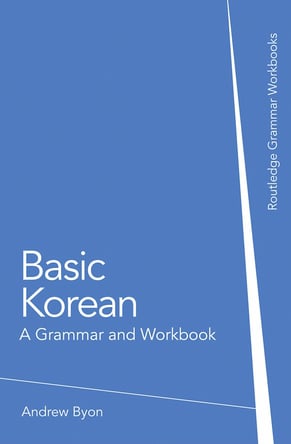Routledge has published a series of grammar workbooks aimed at beginner and intermediate students for a number of languages in recent years, including both basic Korean and intermediate Korean workbooks. The aim is to provide an accessible grammar reference with related exercises in one book, which can be used for self-study, or in the classroom. The Basic Korean textbook has 25 core grammar points which the author expects a student to have studied in their first year and hopes to provide a jargon free explanation to aid understanding. The contents page is relatively simple, there are 25 lessons divided by sections like nouns, counters, special particles, irregular verbs, etc. There is also an answer key and an in-depth glossary provided at the end of the book. Given the structure of the book, you can either pick a particular grammar point you would like to work on or start from page one and work with each lesson from beginning to end.
The preface is short at just two pages; the author explains how it has only been in recent decades that Korean language courses have started to become popular and that many universities in the US now offer them. He further explains that this book addresses a gap in the market as self-study books are only increasing slowly in number and few Korean foreign language grammar workbooks have been published up to now.
"There is little to criticize in this book, apart from the odd vocabulary list, which the author said this book doesn’t include, and sometimes not quite jargon free explanations. It is perfect as either a classroom book or for self-study."
The book is specifically designed for English speaking learners as a supplement to classroom learning. What’s more is that this textbook focuses on explaining grammar structures through supporting exercises, rather than just including vocabulary lists and dialogues. In contrast to many Korean books, the actual Korean writing system, Hangul, is used rather than the Romanized version, accompanied by English translations. Most other books either use only Hangul (which isn’t always useful for understanding grammar) or use English with Romanized Korean (which doesn’t really allow the student to learn Hangul). However, this can be up to the preference of the student as some prefer Hangul and some prefer Romanized Korean when studying as a beginner.
The first lesson or unit introduces Hangul by listing each character of the alphabet and including an easy-to-understand English sentence that shows how the character should sound. The unit ends with eleven exercises to test the student’s comprehension and support their study. It is easy to imagine that if this book was used within the classroom then these exercises could be the homework. Unit two is a bit more heavy as there is a long explanation about the workings of grammar in Korean. The unit also discusses how Korean is both a contextual language and an honorific language. There are three exercises to test the student’s understanding of these concepts. The next unit is about nouns, the student is shown how they are formed and also their characteristics such as plurality, position of nouns and noun usage with verbs. For these exercises the student has to learn a short list of nouns and then complete four exercises.
The next few units cover other areas of the language with easy to understand explanations, a few example sentences, and then the student is also introduced to a lot of Korean vocabulary through these sentences and through the exercises that are given at the end of each unit. Units 9 and 10 teach the basic components for counting using the two sets of numbers that Koreans use, Native Korean and Sino-Korean (derived from Chinese), as well as counters. Just like Japanese, there is a different way for counting depending on what is being counted, i.e. people, objects, etc. It is quite comprehensive and really too much for a beginner student to learn and remember, for example the counter system for trees and flowers isn’t very useful and it’s hard to imagine a situation where a beginner student, or even an intermediate student would need to know this.

Units 12 to 14 are focused on case particles, although difficult to learn, these are extremely important and it is best to master them as early as possible when studying Korean, in a sense these three units are really perfect for either classroom teaching or self-study. Units 15 and 16 go into further detail about special particles. It is very interesting, yet difficult, to study these five units since in most Korean textbooks they are not given any special significance, which leads to students at intermediate level who still struggle to understand how to use the basic building blocks of the language when tested on particles. In this regard it is absolutely perfect not just for a beginner but even for an intermediate student to undertake these five units and really master Korean particles. The following units also cover verb conjugation such as past tense, negation, and irregular verbs; they are extremely useful for gaining command over using verbs not just in exercises, reading and writing, but also in speech.
The final units go into detail about pronouns, adverbs, prefixes and suffixes, which should bring a student full circle in terms of covering basic Korean grammar. There is little to criticize in this book, apart from the odd vocabulary list, which the author said this book doesn’t include, and sometimes not quite jargon free explanations. It is perfect as either a classroom book or for self-study. However, in the classroom it would probably be better used as a homework book and it would be best to have the students read through the grammar explanations in English and complete the exercises.




